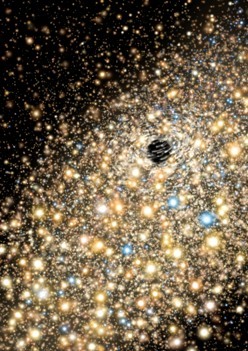CAPE CANAVERAL, Florida (AP) _ Scientists have found the biggest black holes known to exist _ each one 10 billion times the size of our sun.
A team led by astronomers at the University of California, Berkeley, discovered the two gigantic black holes in clusters of elliptical galaxies more than 300 million light years away. That's relatively close on the galactic scale.

``They are monstrous,'' Berkeley astrophysicist Chung-Pei Ma told reporters. ``We did not expect to find such massive black holes because they are more massive than indicated by their galaxy properties. They're kind of extraordinary.''
The previous black hole record-holder is as large as 6 billion suns.
In research released Monday by the journal Nature, the scientists suggest these black holes may be the leftovers of quasars that crammed the early universe. They are similar in mass to young quasars, they said, and have been well hidden until now.
The scientists used ground-based telescopes as well as the Hubble Space Telescope and Texas supercomputers, observing stars near the black holes and measuring the stellar velocities to uncover these vast, invisible regions.
Black holes are objects so dense that nothing, not even light, can escape. Some are formed by the collapse of a super-size star. It's uncertain how these two newly discovered whoppers originated, said Nicholas McConnell, a Berkeley graduate student who is the study's lead author. To be so massive now means they must have grown considerably since their formation, he said.
Most if not all galaxies are believed to have black holes at their center. The bigger the galaxy, it seems, the bigger the black hole.
Quasars are some of the most energized and distant of galactic centers.
The researchers said their findings suggest differences in the way black holes grow, depending on the size of the galaxy.
Ma speculates these two black holes remained hidden for so long because they are living in quiet retirement _ much quieter and more boring than their boisterous youth powering quasars billions of years ago.
``For an astronomer, finding these insatiable black holes is like finally encountering people nine feet tall whose great height had only been inferred from fossilized bones. How did they grow so large?'' Ma said in a news release. ``This rare find will help us understand whether these black holes had very tall parents or ate a lot of spinach.''
Oxford University astrophysicist Michele Cappellari, who wrote an accompanying commentary in the journal, agreed that the two newly discovered black holes ``probably represent the missing dormant relics of the giant black holes that powered the brightest quasars in the early universe.''
One of the newly detected black holes weighs 9.7 billion times the mass of the sun. The second, slightly farther from Earth, is as big or even bigger.
Even larger black holes may be lurking out there. Ma said that's the million-dollar question: How big can a black hole grow?
The researchers already are peering into the biggest galaxies for answers.
``If there is any bigger black hole,'' Ma said, ``we should be able to find them in the next year or two. Personally, I think we are probably reaching the high end now. Maybe another factor of two to go at best.''
<한글 기사>
태양 100억 배 크기의 블랙 홀 발견
질량이 우리 태양의 100억배나 되는 천문학 관측사상 최대의 블랙홀 2개가 발견됐다고 스페이스 닷컴이 5일 미국 과학자들의 발표를 인용 보도했다.
버클리 캘리포니아대학 연구진은 지구에서 3억광년 이상 떨어진 사자자리 은하 단 안의 가장 밝은 은하 NGC 3842 중심부에서 질량이 우리 태양의 97억배인 블랙홀 을, 3억3천500만광년 떨어진 머리털자리 안의 가장 밝은 은하 NGC 4889 중심부에서 이와 비슷하거나 더 큰 블랙홀을 발견했다고 네이처지에 발표했다.
이처럼 질량이 큰 블랙홀의 존재 가능성은 예측돼 오긴 했지만 지금까지 실제로 발견된 가장 큰 블랙홀은 처녀자리 M87 은하 중심부의 것으로 질량이 태양의 63억배 정도이다.
대부분의 은하들은 중심부에 거대한 블랙홀을 갖고 있는 것으로 생각되지만 이번에 발견된 것들은 주변 은하들을 기준으로 할 때 예상보다 각각 1.6배와 4.6배 커 거대 블랙홀이 어떻게 자라는지에 관해 새로운 의문을 던져주는 것이다.
연구진은 하와이의 제미니와 케크 천문대, 텍사스의 맥도널드 천문대를 이용해 이 두 은하의 중심부 주위를 도는 별들의 속도를 관측했다. 이런 속도는 별들이 가진 중력의 세기, 더 나아가 중심부에 있는 블랙홀의 질량을 말해주는 것이다.
새로 발견된 블랙홀들의 질량은 우리은하 중심부 블랙홀의 2천500배에 달하며 이 둘의 `사건의 지평선'(블랙홀 주변에서 빛이 빠져 나올 수 없는 한계)은 태양-명 왕성 거리의 5배나 된다. 이에 비해 우리은하 블랙홀의 `사건의 지평선'은 수성 궤도의 5분의1에 불과하다.
연구진은 "이 두 블랙홀은 어린 퀘이사(준성<準星>: 별 모양의 초거대 은하핵) 와 질량이 비슷해 어쩌면 퀘이사와 초대질량 블랙홀 사이의 빠진 고리일지도 모른다 "고 말했다.
이들은 이 블랙홀들이 더 이상 강착되는 가스의 공급을 받지 못해 숨어서 잠자고 있는 중일지도 모른다고 지적했다.
연구진은 작은 은하들이 합쳐져 큰 은하가 되고 이 과정에서 두 작은 은하의 중 심부에 있던 블랙홀들도 합쳐져 큰 블랙홀이 된다는 사실은 알고 있지만 주변의 가스를 먹고 블랙홀이 더 커질 수도 있다고 말했다.
따라서 이 두 블랙홀이 왜 그처럼 커졌는지에 관한 의문은 마치 키 큰 아이에게 "키 큰 부모를 뒀느냐, 아니면 시금치를 많이 먹었느냐"고 묻는 것처럼 답할 수 없는 문제라고 말했다.










![[Kim Seong-kon] Democracy and the future of South Korea](http://res.heraldm.com/phpwas/restmb_idxmake.php?idx=644&simg=/content/image/2024/04/16/20240416050802_0.jpg&u=)








![[Today’s K-pop] Zico drops snippet of collaboration with Jennie](http://res.heraldm.com/phpwas/restmb_idxmake.php?idx=642&simg=/content/image/2024/04/18/20240418050702_0.jpg&u=)